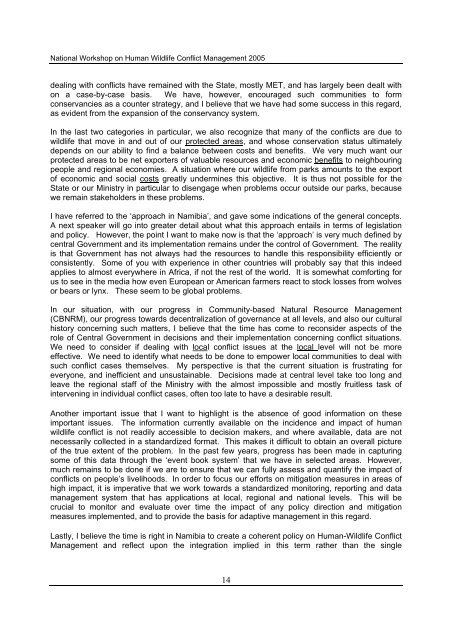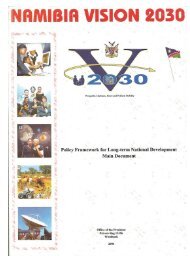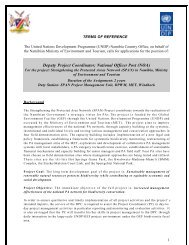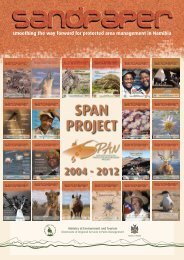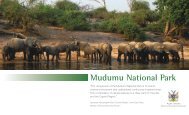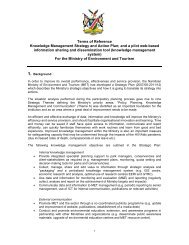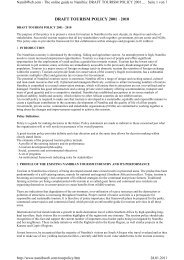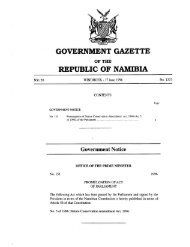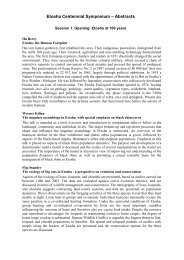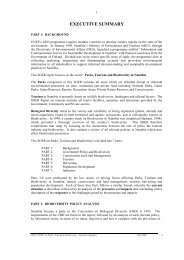HWCM - Ministry of Environment and Tourism
HWCM - Ministry of Environment and Tourism
HWCM - Ministry of Environment and Tourism
You also want an ePaper? Increase the reach of your titles
YUMPU automatically turns print PDFs into web optimized ePapers that Google loves.
National Workshop on Human Wildlife Conflict Management 2005<br />
dealing with conflicts have remained with the State, mostly MET, <strong>and</strong> has largely been dealt with<br />
on a case-by-case basis. We have, however, encouraged such communities to form<br />
conservancies as a counter strategy, <strong>and</strong> I believe that we have had some success in this regard,<br />
as evident from the expansion <strong>of</strong> the conservancy system.<br />
In the last two categories in particular, we also recognize that many <strong>of</strong> the conflicts are due to<br />
wildlife that move in <strong>and</strong> out <strong>of</strong> our protected areas, <strong>and</strong> whose conservation status ultimately<br />
depends on our ability to find a balance between costs <strong>and</strong> benefits. We very much want our<br />
protected areas to be net exporters <strong>of</strong> valuable resources <strong>and</strong> economic benefits to neighbouring<br />
people <strong>and</strong> regional economies. A situation where our wildlife from parks amounts to the export<br />
<strong>of</strong> economic <strong>and</strong> social costs greatly undermines this objective. It is thus not possible for the<br />
State or our <strong>Ministry</strong> in particular to disengage when problems occur outside our parks, because<br />
we remain stakeholders in these problems.<br />
I have referred to the ‘approach in Namibia’, <strong>and</strong> gave some indications <strong>of</strong> the general concepts.<br />
A next speaker will go into greater detail about what this approach entails in terms <strong>of</strong> legislation<br />
<strong>and</strong> policy. However, the point I want to make now is that the ‘approach’ is very much defined by<br />
central Government <strong>and</strong> its implementation remains under the control <strong>of</strong> Government. The reality<br />
is that Government has not always had the resources to h<strong>and</strong>le this responsibility efficiently or<br />
consistently. Some <strong>of</strong> you with experience in other countries will probably say that this indeed<br />
applies to almost everywhere in Africa, if not the rest <strong>of</strong> the world. It is somewhat comforting for<br />
us to see in the media how even European or American farmers react to stock losses from wolves<br />
or bears or lynx. These seem to be global problems.<br />
In our situation, with our progress in Community-based Natural Resource Management<br />
(CBNRM), our progress towards decentralization <strong>of</strong> governance at all levels, <strong>and</strong> also our cultural<br />
history concerning such matters, I believe that the time has come to reconsider aspects <strong>of</strong> the<br />
role <strong>of</strong> Central Government in decisions <strong>and</strong> their implementation concerning conflict situations.<br />
We need to consider if dealing with local conflict issues at the local level will not be more<br />
effective. We need to identify what needs to be done to empower local communities to deal with<br />
such conflict cases themselves. My perspective is that the current situation is frustrating for<br />
everyone, <strong>and</strong> inefficient <strong>and</strong> unsustainable. Decisions made at central level take too long <strong>and</strong><br />
leave the regional staff <strong>of</strong> the <strong>Ministry</strong> with the almost impossible <strong>and</strong> mostly fruitless task <strong>of</strong><br />
intervening in individual conflict cases, <strong>of</strong>ten too late to have a desirable result.<br />
Another important issue that I want to highlight is the absence <strong>of</strong> good information on these<br />
important issues. The information currently available on the incidence <strong>and</strong> impact <strong>of</strong> human<br />
wildlife conflict is not readily accessible to decision makers, <strong>and</strong> where available, data are not<br />
necessarily collected in a st<strong>and</strong>ardized format. This makes it difficult to obtain an overall picture<br />
<strong>of</strong> the true extent <strong>of</strong> the problem. In the past few years, progress has been made in capturing<br />
some <strong>of</strong> this data through the ‘event book system’ that we have in selected areas. However,<br />
much remains to be done if we are to ensure that we can fully assess <strong>and</strong> quantify the impact <strong>of</strong><br />
conflicts on people’s livelihoods. In order to focus our efforts on mitigation measures in areas <strong>of</strong><br />
high impact, it is imperative that we work towards a st<strong>and</strong>ardized monitoring, reporting <strong>and</strong> data<br />
management system that has applications at local, regional <strong>and</strong> national levels. This will be<br />
crucial to monitor <strong>and</strong> evaluate over time the impact <strong>of</strong> any policy direction <strong>and</strong> mitigation<br />
measures implemented, <strong>and</strong> to provide the basis for adaptive management in this regard.<br />
Lastly, I believe the time is right in Namibia to create a coherent policy on Human-Wildlife Conflict<br />
Management <strong>and</strong> reflect upon the integration implied in this term rather than the single<br />
14


